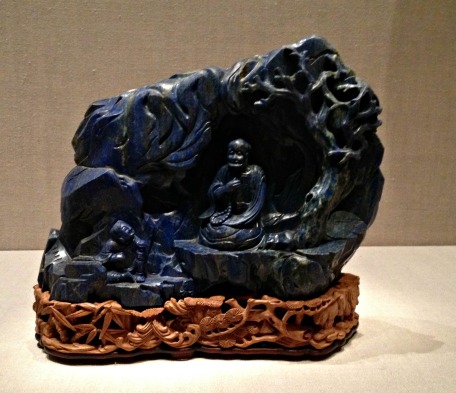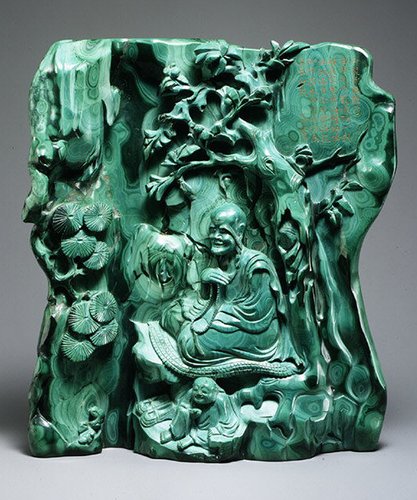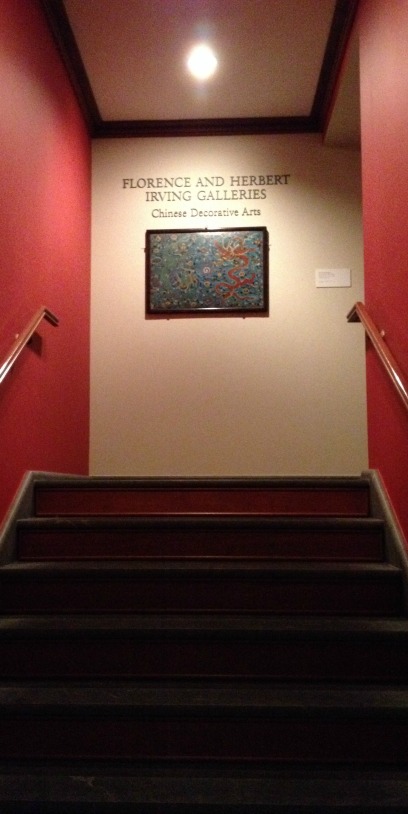
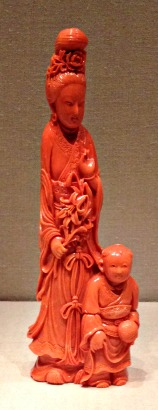 The thunderstorms that hit the New York area last Wednesday and Thursday evening destroyed my plans for a week away, so I ended up spending the Fourth of July in town instead of about 1,500 miles away in Texas.
The thunderstorms that hit the New York area last Wednesday and Thursday evening destroyed my plans for a week away, so I ended up spending the Fourth of July in town instead of about 1,500 miles away in Texas.
I decided to go to the Metropolitan Museum around mid-day on the Fourth, and it was packed then, even before it started to rain, which probably brought more visitors. First I went to Lost Kingdoms: Hindu-Buddhist Sculpture of Early Southeast Asia, 5th to 8th Century, a beautifully installed exhibit of sculpture, and then I decided to take a look at Colors of the Universe: Chinese Hardstone Carvings.Â
And therein lies more than one tale.
Colors of the Universe is an exquisite exhibit, filling just one gallery on the third floor in the Asian wing — up those stairs at left. I am betting it did not get the attention it deserved and, alas, it is closing today — so it won’t. That’s why I have a wish for it: that the Met would send it out to other museums, because the Met owns all — or most — of the pieces in the show.
Further, as I discovered when I searched the web for a review, the Met had put this show on view before. Holland Cotter reviewed it in The New York Times on Dec. 28, 2012, when it was on view through Jan. 6, 2013. Now, according to the Met’s website, it has been up since Dec. 11, 2013 and through today. Cotter wrote:
Each of the show’s 60 miniature sculptures, dating from the Qing dynasty (1644-1911), is a nugget of show-off virtuosity and doesn’t pretend to be much else, though at least a few have ostensible functions…. some of the most memorable works in the show — organized by Jason Sun, a curator in the Asian art department, in the jewel-box Chinese Decorative Arts galleries — are notable for their sheer, look-at-me strangeness. Such is the case with a little dish of peanuts and candied dates sculptured from brown chalcedony. The artist has exquisitely differentiated the surface textures of the nuts and fruits, and pulled an amazingly nuanced range of browns from the quartzlike stone. The results are more phenomenal than beautiful. All the hard work has produced a bizarre, dark, resinous-looking little thing, a consummately wrought novelty-shop item, magnetic for silly reasons. A lot of art’s like that.
Honestly, I don’t remember that piece, though I concede that a few objects in the cases are surprises. The coral Daoist Immortal and Boy was an eye-opener by virtue of its bright , candy-colored orange, to name one. I love the little jade pillow — in the shape of a baby! — also at right.
Two more beautifully carved pieces — Seated Luohan in a Grotto (in lapis lazuli) and another in malachite — are below, at the end of this post.
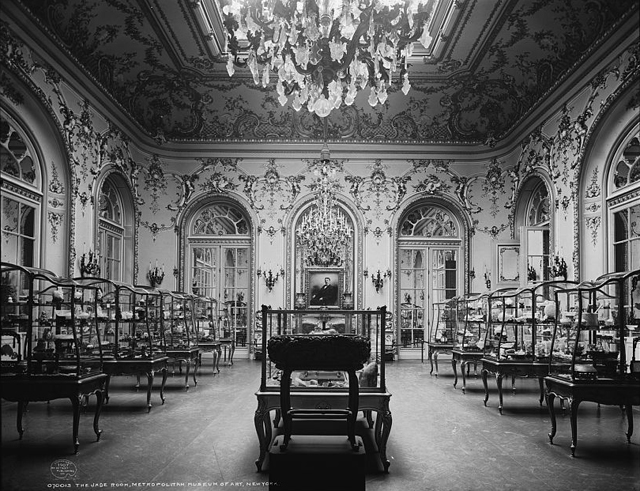 Finally, I discovered something else when I looked up the donor of many, if not most of these objects: Heber R. Bishop, whom Hyperallergic once described as “an incredibly wealthy businessman who was enchanted with jade in all its forms, from geological shards to the most ornate jade carvings of China.”
Finally, I discovered something else when I looked up the donor of many, if not most of these objects: Heber R. Bishop, whom Hyperallergic once described as “an incredibly wealthy businessman who was enchanted with jade in all its forms, from geological shards to the most ornate jade carvings of China.”
That article, published a year ago, revealed that these pieces were once on view in a room of their own, known as the Jade Room, “Â showcased in an opulent room in the style of Louis XV, with fifteen delicate glass cases presided over by a chandelier.” [pictured at left]
But it’s vanished as if it were never there.
The author, Allison Meier, also said:
According to the museum’s 1922 Guide to the Collections, the Bishop Jade Room contained “a collection bequeathed to the museum by Herber R. Bishop with the condition that it should be exhibited in a room reproducing the owner’s ballroom. The rich and very complete collection of jades is arranged according to the different colors and kinds, and contains not only Chinese jades but different kinds found in India, New Zealand, Nebraska, Mexico, and amongst the prehistoric remains of the Swiss lake dwellers.â€
She didn’t get an answer from the Met about the jade room’s demise. In a way, Colors of the Universe is a recreation of the Jade Room, but in much sparer, more Asian galleries — and not all jade. Plus, there are pieces donated by other collectors, such as Edmund C. Converse, who donated the malachite carving below.
So, should this exhibit remain on view all the time? Or, better, be shared with other museums and publics that don’t have the riches of the Met? I vote for the latter.
UPDATE, 7/8: The Met tells me that it has just extended this exhibit until March 8, 2015.
Photo Credits: Courtesy of Hyperallergic (Jade Room), The New York Times (malachite carving). All others:  © Judith H. Dobrzynski Â

